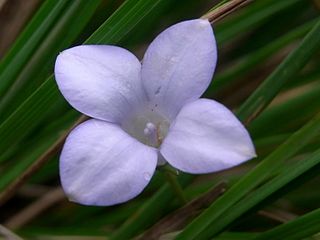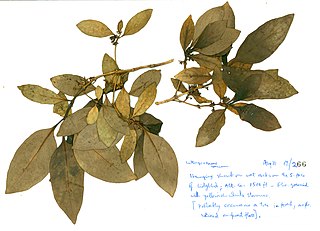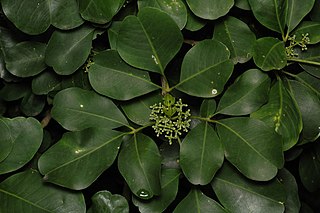
Myrsine is a genus of flowering plants in the family Primulaceae. It was formerly placed in the family Myrsinaceae before this was merged into the Primulaceae. It is found nearly worldwide, primarily in tropical and subtropical areas. It contains over 280 species, including several notable radiations, such as the matipo of New Zealand and the kōlea of Hawaiʻi. In the United States, members of this genus are known as colicwood. Some species, especially M. africana, are grown as ornamental shrubs.

Myrsine howittiana, the brush muttonwood or muttonwood, is a shrub or small tree in the family Primulaceae. The species is endemic to eastern Australia.

Cassinia tenuifolia, commonly known as bully bush or killmoke, is a species of flowering plant in the family Asteraceae and is endemic to Lord Howe Island. It is a dense, bushy shrub with hairy young stems, crowded linear leaves and sweetly scented flower heads arranged in corymbs.
Lepidium nesophilum is a species of flowering plant in the mustard and cabbage family that is endemic to the subtropical Lord Howe Island in the Tasman Sea between Australia and New Zealand.

Wahlenbergia insulae-howei is a flowering plant in the bellflower family. The specific epithet alludes to Lord Howe Island, where it is found.
Corokia carpodetoides, simply known locally as corokia, is a flowering plant in the Argophyllaceae family. The specific epithet derives from a resemblance to the genus Carpodetus, with the addition of the Latin suffix -oides (“resembling”).
Westringia viminalis is a flowering plant in the mint family. The specific epithet refers to its long, slender shoots. It is closely related to Westringia fruticosa, which is found on coastal heath and cliffs in New South Wales.
Myrsine mccomishii is a flowering plant in the family Primulaceae. It is a tree endemic to Lord Howe Island. The specific epithet honours James Doran McComish (1881–1948), who made several visits to, and collected extensively on, Lord Howe Island in the 1930s.

Myrsine platystigma is a flowering plant in the family Primulaceae. It is a shrub or tree endemic to Lord Howe Island. The specific epithet comes from the Greek platys (“broad”) and stigma, with reference to the relatively broad stigma.

Coprosma huttoniana is a flowering plant in the family Rubiaceae. The specific epithet honours Ian Hutton, the Lord Howe Island based naturalist who discovered the plant and recognised it as a new species.

Coprosma lanceolaris is a flowering plant in the family Rubiaceae. The specific epithet comes from the Latin lancea with the suffix -aris, alluding to the shape of the leaves.

Coprosma putida, commonly known as stinkwood, is a flowering plant in the family Rubiaceae. The Latin specific epithet putida means "stinking", alluding to the stench produced when the plant is cut or bruised, including the leaves and fruit.
Psychotria carronis, commonly known as the black grape, is a flowering plant in the coffee family. The specific epithet honours William Carron (1823–1876) who collected plants on Lord Howe Island for the Royal Botanic Gardens, Sydney.
Melicope contermina is a species of shrub or small tree in the family Rutaceae and is endemic to Lord Howe Island. It has trifoliate leaves and white flowers borne in leaf axils in panicles of nine to fifteen flowers.

Melicope polybotrya is a species of shrub or small tree in the family Rutaceae and is endemic to Lord Howe Island. It has trifoliate leaves and green flowers borne in short panicles in leaf axils.
Exocarpos homalocladus, commonly known as the grass tree, is a flowering plant in the sandalwood family. The specific epithet comes from the Greek homalos (“flat”) and clados, with reference to the structure of the plant.
Melicytus novae-zelandiae subsp. centurionis is a flowering plant in the family Violaceae. It is a subspecies of Melicytus novae-zelandiae, known in New Zealand as coastal mahoe. The subspecific epithet honours the military Captain James Doran McComish (1881–1948), who made several visits in the 1930s to collect plants on Lord Howe Island.

Olearia elliptica subsp. praetermissa is a flowering plant in the family Asteraceae. The subspecific epithet means "overlooked", referring to the fact that this distinctive endemic subspecies was long overlooked.
Leptospermum polygalifolium subsp. howense, commonly known as tea tree or tea-tree, is a flowering plant in the myrtle family, Myrtaceae. The subspecific epithet refers to the island to which the subspecies is endemic.
Elatostema grande is a flowering plant in the nettle family. The specific epithet alludes to the relatively large leaves and inflorescences.









